[J]uice made a lot of sense as a new addition to Black Coffee Roasting Company’s diverse menu. The Missoula, Montana, roastery and café that is housed in a large Quonset hut had long featured on-tap kombucha, brazil-nut milk, and house-made shrubs, drinking vinegars made with fruits and vegetables. Adding a line of juices was really just a matter of formulating some tasty recipes.
This year they launched three juices, named by their colors: red, orange, and green. What each of those juices includes will depend on the season. Co-owner Jim Chapman says, “When we decided to do juices, we made the decision to not be rigid in our menu offerings, but to make juices that use produce that is available, fresh, and ripe for juicing.”
Red, for now, is beet, apple, carrot, lemon, and ginger, and for a two-ounce shot of this fruitful, organic cocktail, Black Coffee is charging $2.
That’s another reason juice made a lot of sense to the shop, and why other cafés are looking for ways to incorporate juice into their menus. Charlie Wettlaufer is the VP of sales and marketing at Goodnature, a manufacturer of cold presses that his father founded when he built a futuristic cider press in the 1970s. Wettlaufer says a sixteen-ounce glass of fresh-squeezed juice can sell for $6 to $11, depending on the ingredients and locale. He says a shop making its own juice can pull in a 60 percent margin on the product, while one selling juice pressed by another company will see a 30 percent margin.
A margin like that is worth some consideration. To help you get started, here’s a primer on what a juice program needs.
But before we begin: there’s plenty of debate over the term raw juice and even more over the science of its health benefits. We’re going to leave all that to the side and focus on what it takes to bring fresh-that-day, unpasteurized juice to your shop.

Countertop Crush
Before you go buy fruits and veggies and look for that juicer you got three birthdays ago, understand that juice requires counter space. “If you’re launching from the beginning as a concept of coffee, food, and juice, it’s totally doable,” Wettlaufer says. “If you’re a 300-square-foot café, it might be impossible.”
Black Coffee was able to add juice because they have an expansive bar space. “We have a dynamic work space that allows for a lot of flexibility,” Chapman says.
If you had a hard time fitting an extra grinder on your bar, you might not want to crush a juice operation in there.
Also, bringing in juice means dealing with a new supply chain, one made of highly perishable items. Wettlaufer says, “If you sell salads and sandwiches, you probably already source produce.” If you don’t, that’s a line of research you need to pursue to find suppliers who can guarantee the fresh, high-quality produce you’ll need.
Refrigerator Space
Countertop territory won’t be your only space constraint. Likely the biggest factor that will determine your work flow or if you decide you can do juice at all is your refrigerator capacity. If you have ample prep room during business hours along with refrigerator space, you can make the juice to order. Likely, though, you don’t have room to refrigerate boxes of beets and bushels of chard, so produce will need to be purchased and processed immediately.
Many shops will grind their produce ahead of time or, most likely, do all their juicing before they open shop. That’s an efficient use of your limited real estate. Wettlaufer says, “You can dedicate whatever kitchen space you have for an hour or two.” At Black Coffee, the team juices produce the day its bought, and then refrigerates the juice in glass jars. The process happens only every couple of days.
Regulations
By now, you’ve probably been thinking, why wouldn’t I just buy raw, unpasteurized juice from a local company? Understandable. You could just tuck it alongside other RTD bottles you have, right? But that’s not an option because it’s illegal. Regulatoraly speaking, raw juice is sort of like raw milk: a farmer can sell it to a customer, but the farmer can’t sell it to a store that sells it. If you pressed the juice, you can sell it. If not, no dice.

Juicers
What machine do you need to take all that pretty produce and turn it into a dried out mess of spent fibers? Aside from citrus-only juicers, there are three categories of juicers, each of which has positives and minuses.
Centrifugal
These juicers work by shredding vegetables and then spinning the pulp so fast it presses against a metal sieve and expresses the juice. These are the most common juicers you’ll find at a home goods store. Prices range from a few hundred dollars for a home model (which would likely wear out quickly in a café) to a couple thousand for commercial models that can rip through whole fruit.
A major downside is that these sound like a blender with the lid off or a saw cutting wood or a weed whacker at work: they’re loud. That makes to-order juice a noisy prospect, so prepping batches before opening will make the most sense, especially to small shops. Another issue is that they don’t process leafy vegetables very well.
Masticating
These are the juicers that people refer to as cold presses when talking about home or low-volume use. Masticating juicers draw produce down a chute into a horizontal auger that crushes the produce and presses out the juice. Along with fruits and veggies, masticating juicers can process leafy greens, wheatgrasses, and even nuts for nut milks.
Their main problem is they aren’t very fast and they aren’t made for heavy-duty use. If you wanted made-to-order juice, you’d have to run a couple of these at a time, at least. You also have to cut up large produce before it goes in the chute.
Hydraulic Press
These are the juicers that juice companies use. Essentially, they’re modern versions of a cider or wine press, which just squeeze the goodness out of fruit. The fruits and vegetables, including greens, are shredded and placed in a bag that is then pressed by a hydraulic arm to express the juice. This is the least common type of countertop juicer; the only available models are the low-volume Norwalk Ultimate Juicer and Goodnature’s Countertop, which debuted last year.
Because you have to process the produce before juicing, the noise factor is at play here, so pre-grinding is recommended.
Organic vs Conventional
Because so much of juice’s appeal comes from its health benefits, it may seem organic is the way to go. Wettlaufer cautions it might not be. “If you want to do organic, that’s awesome—if you have the market for it.” He points out that organic produce is substantially more expensive than conventional, so your prices will have to match. Prices at and above $10 for a pint aren’t unusual. “You need a lot of people with a lot of money to do that,” he says. “You should consider doing organic and conventional so you can have some options.”
















